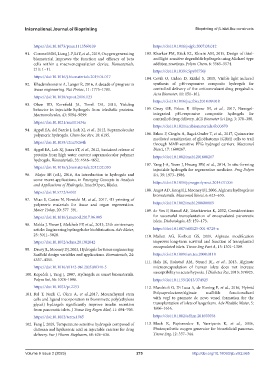Page 283 - IJB-9-2
P. 283
International Journal of Bioprinting Bioprinting of β-islet-like constructs
https://doi:10.1073/pnas.1113560109 https://doi:10.1016/j.ejpb.2007.08.012
91. Coronel MM, Liang J-P, Li Y, et al., 2019, Oxygen generating 103. Kharkar PM, Kiick KL, Kloxin AM, 2015, Design of thiol-
biomaterial improves the function and efficacy of beta and light-sensitive degradable hydrogels using Michael-type
cells within a macroencapsulation device. Biomaterials, addition reactions. Polym Chem, 6: 5565–5574.
210: 1–11. https://doi:10.1039/c5py00750j
https://doi:10.1016/j.biomaterials.2019.04.017 104. Cevik O, Gidon D, Kizilel S, 2015, Visible-light-induced
92. Khademhosseini A, Langer R, 2016, A decade of progress in synthesis of pH-responsive composite hydrogels for
tissue engineering. Nat Protoc, 11: 1775–1781. controlled delivery of the anticonvulsant drug pregabalin.
Acta Biomater, 11: 151–161.
https://doi:10.1038/nprot.2016.123
https://doi:10.1016/j.actbio.2014.09.018
93. Olsen BD, Kornfield JA, Tirrell DA, 2010, Yielding
behavior in injectable hydrogels from telechelic proteins. 105. Cinay GE, Erkoc P, Alipour M, et al., 2017, Nanogel-
Macromolecules, 43: 9094–9099. integrated pH-responsive composite hydrogels for
controlled drug delivery. ACS Biomater Sci Eng, 3: 370–380.
https://doi:10.1021/ma101434a
https://doi:10.1021/acsbiomaterials.6b00670
94. Appel EA, del Barrio J, Loh XJ, et al., 2012, Supramolecular
polymeric hydrogels. Chem Soc Rev, 18: 6195. 106. Erkoc P, Cingöz A, Bagci-Onder T, et al., 2017, Quinacrine
mediated sensitization of glioblastoma (GBM) cells to trail
https://doi:10.1039/c2cs35264h through MMP-sensitive PEG hydrogel carriers. Macromol
95. Appel EA, Loh XJ, Jones ST, et al., 2012, Sustained release of Biosci, 17: 1600267.
proteins from high water content supramolecular polymer https://doi:10.1002/mabi.201600267
hydrogels. Biomaterials, 33: 4646–4652.
107. Yang J-A, Yeom J, Hwang BW, et al., 2014, In situ-forming
https://doi:10.1016/j.biomaterials.2012.02.030
injectable hydrogels for regenerative medicine. Prog Polym
96. Majee SB (ed.), 2016, An introduction to hydrogels and Sci, 39: 1973–1986.
some recent applications, in Emerging Concepts in Analysis https://doi:10.1016/j.progpolymsci.2014.07.006
and Applications of Hydrogels, IntechOpen, Rijeka.
108. Augst AD, Kong HJ, Mooney DJ, 2006, Alginate hydrogels as
https://doi:10.5772/64301
biomaterials. Macromol Biosci, 6: 623–633.
97. Miao S, Castro N, Nowicki M, et al., 2017, 4D printing of
polymeric materials for tissue and organ regeneration. https://doi:10.1002/mabi.200600069
Mater Today, 20: 577–591. 109. de Vos P, Hamel AF, Tatarkiewicz K, 2002, Considerations
https://doi:10.1016/j.mattod.2017.06.005 for successful transplantation of encapsulated pancreatic
islets. Diabetologia, 45: 159–173.
98. Malda J, Visser J, Melchels FP, et al., 2013, 25th anniversary
article: Engineering hydrogels for biofabrication. Adv Mater, https://doi:10.1007/s00125-001-0729-x
25: 5011–5028. 110. Mallett AG, Korbutt GS, 2009, Alginate modification
https://doi:10.1002/adma.201302042 improves long-term survival and function of transplanted
encapsulated islets. Tissue Eng Part A, 15: 1301–1309.
99. Drury JL, Mooney DJ, 2003, Hydrogels for tissue engineering:
Scaffold design variables and applications. Biomaterials, 24: https://doi:10.1089/ten.tea.2008.0118
4337–4351. 111. Hals IK, Rokstad AM, Strand BL, et al., 2013, Alginate
https://doi:10.1016/s0142-9612(03)00340-5 microencapsulation of human islets does not increase
100. Kopeček J, Yang J, 2007, Hydrogels as smart biomaterials. susceptibility to acute hypoxia. J Diabetes Res, 2013: 374925.
Polym Int, 56: 1078–1098. https://doi:10.1155/2013/374925
https://doi:10.1002/pi.2253 112. Marchioli G, Di Luca A, de Koning E, et al., 2016, Hybrid
101. Bal T, Nazli C, Okcu A, et al.,2017, Mesenchymal stem Polycaprolactone/alginate scaffolds functionalized
cells and ligand incorporation in biomimetic poly(ethylene with vegf to promote de novo vessel formation for the
glycol) hydrogels significantly improve insulin secretion transplantation of islets of langerhans. Adv Healthc Mater, 5:
from pancreatic islets. J Tissue Eng Regen Med, 11: 694–703. 1606–1616.
https://doi:10.1002/term.1965 https://doi:10.1002/adhm.201600058
102. Fang J, 2008, Temperature-sensitive hydrogels composed of 113. Bloch K, Papismedov E, Yavriyants K, et al., 2006,
chitosan and hyaluronic acid as injectable carriers for drug Photosynthetic oxygen generator for bioartificial pancreas.
delivery. Eur J Pharm Biopharm, 68: 626–636. Tissue Eng, 12: 337–344.
Volume 9 Issue 2 (2023) 275 http://doi.org/10.18063/ijb.v9i2.665

